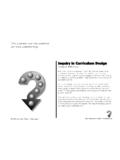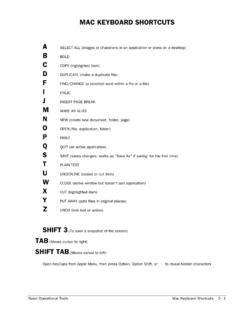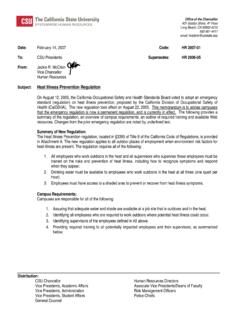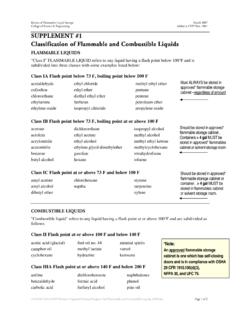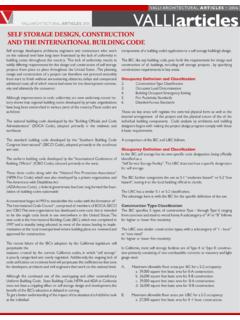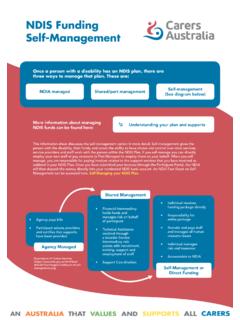Transcription of New Employee Safety Orientation Self-Study Handbook
1 New Employee Safety Orientation Self-Study Handbook Non-Hazardous Materials Version August 2008 Welcome to San francisco State university (SFSU). SFSU is dedicated to providing its employees with a safe work environment. This self -administered training booklet has been developed to ensure that you receive and understand the requirements of SFSU health and Safety programs, especially those developed for College of Science and Engineering (COSE). Cal-OSHA requires that all employees receive Injury and Illness Prevention Program (IIPP) training. This guide is one method by which we can fulfill these training requirements.
2 We can also provide this training in a lecture format. Contact our office at 8-6892 or 8-7507 for more information. What to do with this Handbook . To use this self -administered training Handbook , you must read this training document, complete the attached Quiz / Employee Acknowledgement form. When finished, turn in the Quiz form to your department office/stockroom or to your supervisor. Thank you for taking time to learn about the Safety programs at SFSU. Feel free to call us at extension 8-6892 if you have any questions. Who is this Handbook for? This Handbook is suitable for temporary-status employees ( , lecturers, assistants), who do not regularly work with hazardous materials in work environments such as Offices Lecture Classes Computer Labs Most Engineering Labs Quantitative Analysis Labs Most Physics Labs What information is covered in this Handbook ?
3 Part 1. Injury and Illness Prevention Program Reviews provisions of the written Safety program for the College of Science and Engineering, including inspections and training. Part 2. Employee Right-To-Know Program Reviews the written Hazard Communication Program with an emphasis on the office and computer lab environment. Part 3. Ergonomics Program Reviews the basics of repetitive motion injuries and provides information about the university Ergonomics Safety Program. Part 4. Bloodborne Pathogen Prevention Program Reviews protection from bloodborne diseases in a non-medical environment.
4 Part 5. Responding to Emergencies Reviews building evacuation procedures. New Employee Safety Orientation Self-Study Handbook for Temporary Lecturers, Staff, and Student Employees Who Don t Work with Hazardous Materials Part 1 Injury And Illness Prevention Program 1. What is the Injury and Illness Prevention Program? The IIPP is a written general Safety program that applies to all university employees and includes: Employee Safety training Employee Safety Meetings Safety inspections and audits Accident investigations Communication of Safety information Other health and Safety programs: Hazard Communication Ergonomics Bloodborne Pathogens 2.
5 How is Safety communicated? Employee training By departmental Safety meetings/training and SFSU Employee Safety Committee Through memoranda and emails to employees, supervisors, and project directors; at new hire orientations; and on the SFSU web site. 3. How often do I need to be trained? When you are a new Employee and/or given a new job assignment. Whenever new substances, processes, procedures, or equipment are introduced to the workplace and represent a new hazard. Whenever the university becomes aware of a new, previously unrecognized hazard. 4.
6 Does the IIPP include training on general safe work practices? Yes, and every Employee must observe the following work practices: Know the Safety rules and procedures that apply to the work that is being done. Determine the potential hazards ( , physical, chemical, biological) and take appropriate Safety precautions before beginning any new operation. Be alert to unsafe conditions and actions and call attention to them so that corrections can be made as soon as possible. Know the location of, and how to use, the emergency equipment in your area, as well as how to obtain additional help in an emergency.
7 Be familiar with emergency procedures by: Reviewing Emergency Procedures posted in your dept office and common areas. Becoming familiar with how to safely exit the building you work in and knowing where to go once outside the building. Page 1 of 12 8/2008 New Employee Safety Orientation Self-Study Handbook for Temporary Lecturers, Staff, and Student Employees Who Don t Work with Hazardous Materials 5. What fire and electrical Safety hazards do I need to be aware of? Fires resulting from poor chemical storage practices, overloaded circuits, and careless use of heat and spark sources cause needless property damage and risk to employees, students, and the public.
8 The following items are examples of poor and risky practices: Plugging in too many appliances and instruments into an outlet or power strip Daisy-chaining plugging extension cords into other extension cords or power strips Storing flammable liquids near spark sources, heating elements, or distillation units Dispensing flammable gases and liquids without properly grounding and bonding the containers allowing static electricity to build up and possibly igniting the material Using damaged electrical cords or plugs, or allowing them to get wet 6. What does housekeeping have to do with Safety ?
9 There is a definite relationship between Safety and orderliness in the work area or laboratory. When housekeeping standards fall, Safety inevitably deteriorates. The work area must be kept clean and orderly. Work areas must be kept clean and free from obstructions. Cleanup should follow the completion of any messy operation, or at the end of each day. Trash should be deposited in appropriate receptacles. Stairs and hallways are not to be used as storage areas. Access to exits, emergency equipment, control panels, and fire extinguishers must never be blocked.
10 Chemicals must be stored and labeled properly. Consult manufacturer s guidelines and the Material Safety Data sheets (MSDS), or appropriated storage requirements 7. What are my rights as an Employee ? You have the right to a safe work environment. You have the right to be informed of any operation in your work area where hazardous substances or industrial hazards are present. You have the right to be informed of the locations and availability of hazardous materials use information (Material Safety Data Sheets) and or any other Safety procedure or information necessary to perform your work assignment safely.
